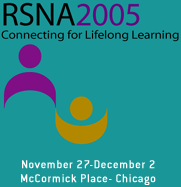
Abstract Archives of the RSNA, 2005
David J. Gladstone, Presenter: Nothing to Disclose
Alan Charles Hartford MD, PhD, Abstract Co-Author: Nothing to Disclose
John Frederick Marshall, Abstract Co-Author: Nothing to Disclose
Charles Clanton Rogers MD, Abstract Co-Author: Nothing to Disclose
John D. Seigne MD, Abstract Co-Author: Nothing to Disclose
Eugen B. Hug MD, Abstract Co-Author: Nothing to Disclose
Purpose/Objective: Prostate motion is well documented in the literature and remains a major contributor to the margins included in PTV definitions for treatment with external beam radiation therapy. Implantable fiducial markers are under current investigation at many centers to be used for image guided radiation therapy. The ultimate goal is to reduce the margins needed for the PTV and make dose escalation safe for surrounding critical structures. We report on a new implantable fiducial marker which is useful for this purpose. Materials/Methods: VisiCoil is a gold coil, 0.75 mm in diameter, and available in lengths from 1cm to 6 cm. Ten patients have been implanted with these new fiducial markers. Two coils, matching the length of the prostate were implanted under ultrasound guidance for use in image guided radiotherapy for each of these ten patients. The coils were identified in the treatment planning process and were used for treatment field placement. Before treatment, the coils were identified in electronic portal images and patient shifts were determined based on the coil location in the setup fields. Patient position was adjusted to bring the prostate to the desired treatment position before the therapeutic dose was delivered. Results: The insertion technique for coils is comparable to that of conventional seeds. Since coils span the length of the gland, ultrasound guidance was used for coil placement. Without exception, the gold coils were visible in DRR reference images as well as in electronic portal images. Image matching was successful in determining anatomic shifts to increase the accuracy of treatment and such shifts were applied to patients before therapy was delivered. Due to the length of the coils and their unique shapes, there was no instance of confusion over which marker was which during the matching procedures. Conclusions: Gold coils have been used successfully as fiducial markers of prostate location for image guided radiotherapy. Coils offer advantages over seed type markers in stability, 3-D visualization, and the elimination of marker ambiguity
Gladstone, D,
Hartford, A,
Marshall, J,
Rogers, C,
Seigne, J,
Hug, E,
Gold Coils Used as Fiducial Markers of Prostate Location for Image-guided Radiotherapy. Radiological Society of North America 2005 Scientific Assembly and Annual Meeting, November 27 - December 2, 2005 ,Chicago IL.
http://archive.rsna.org/2005/4420620.html

